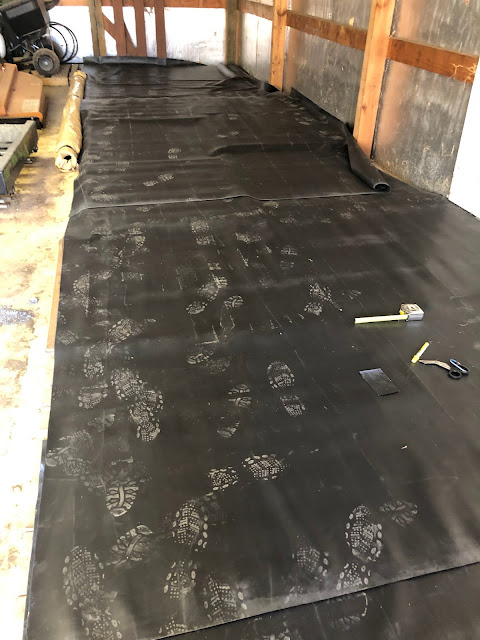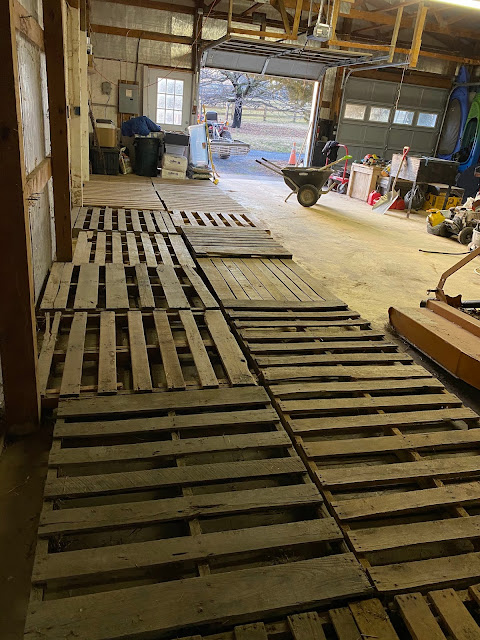It has been almost exactly three years since I installed my O2 Compost aerated compost system so I have been thinking again about how it has worked for me.
As background, here are my previous posts on the system:
Bin Construction
The Composting Process
Spreading
Is It Right For You?
Pallet Floors for Air Pipes
After three years I have sort of a love/hate relationship with my compost bins. I love that I don't have to call some guy, wait for him to come swap dumpsters, then watch as he spins tires in my gravel driveway. Or better yet, as he blows his transmission because he doesn't know how to tow a heavy load and just decided to floor it, has his crippled truck towed across my backyard, then blames me for it all--true story!
I hate that emptying the bins requires so much backbreaking labor. The tractor can only do so much because the loader can't reach the back of the bins and can't fit around the aeration pipes. Even if the loader could reach, my wooden bins aren't sturdy enough to withstand being scraped and shoved by the tractor. A more permanent and expensive system with concrete sides and pipes recessed into the floor would be much easier to empty without manual labor but would also be, well, more permanent and expensive.
However, like any good farm owner, I'm used to hard work so what I really hate is that the "compost" looks almost exactly the same coming out as it did going in because I only have room for two bins so I usually can't let it cure. After a month or even two months of curing it still looks just like stall waste.
 |
| This has been curing for a month or two and yep, it's definitely still horse sh!t. |
 |
| Circumstances allowed me to cure this compost for the longest I ever have, which was about 5-6 months. It has reduced in size somewhat and is drier than my usual batches, but it's still not that crumbly uniform compost that I was hoping for. Further down and along the wall between the two bins it was still pretty wet. |
Meanwhile, it turns out that my stall pickings (manure plus bagged sawdust bedding) have the perfect composition to naturally fall in or just above the "active" temperature range as they are added to the bin. I might be wrong but my interpretation is that just by being piled up for a few days my stall waste is getting hot enough to kill pathogens and weed seeds, which for me is the main goal since apparently it's never going to cure enough to be nice finished compost anyway.
 |
| Yesterday's stall waste, already in the active range with no human intervention. |
So then why am I shoveling all that waste into the bins only to shovel it all back out later? Over my six years of horsekeeping, my husband has developed a good-natured hatred of helping me undo things that have already been done. Example: we use T-posts and electric tape to subdivide the dry lot when I have an extra horse that can't get turned out with the others, and when that horse leaves in a year we remove the T-posts and electric tape. Another example: he builds a lovely stall divider for my mini-donkey, which he helps me remove when the new horse arrives because it needs the stall, then helps me replace when the new horse leaves so the donkey can have his stall back. Even though I think it's normal for my needs to change or for me to experiment with things then realize they don't work, I understand his objection to the Sisyphean nature of some tasks with which he kindly assists me. Helping me shovel horse poo out of the compost bins only to watch the "ungrateful horses" (his words, only partially joking and actually quite accurate) immediately fill them up again seems to fit in this category.
 |
| My husband rolling a giant ball of horse manure up a mountain for all eternity. |
So all of this makes me wonder, what if instead of dumping wheelbarrows full of stall waste into compost bins only to move them to the manure spreader rather laboriously a few weeks later, looking much the same, I just dumped stall waste straight into the manure spreader? It would save quite a lot of time and effort, and my husband could absent himself from the farm's "waste management system" entirely, for which I'm sure he would be quite grateful. He's a good sport about it but in three years of helping me empty compost bins he has developed a strong distaste for horse manure, which didn't bother him at all pre-compost.
If the waste is getting hot enough all by itself to kill weed seeds and pathogens and it isn't curing long enough to be true compost anyway, what would I be losing if I mucked directly into the spreader and spread the waste on the pastures just a few weeks sooner, without aeration?
Direct spreading is a common practice, including amongst my neighbors. Ohio State's Agricultural Extension has a great fact sheet about it that you can find
here. The takeaway is that although horse manure can be beneficial fertilizer, the sawdust or wood shavings in stall waste stunt crop/grass growth by inducing a nitrogen deficiency. To avoid this, you can add a small amount of nitrogen fertilizer to each wheelbarrow of waste. This seems so much simpler to me than my current system that I decided to try it.
Some of the constraints that might stop some farms from direct spreading don't affect me. It's environmentally unsound and in some places illegal to spread manure in the winter, but my horses are not stalled at all in the winter anyway so there's no stall waste to worry about. In some areas the ground can be too muddy or boggy for weeks on end to spread without tearing up your fields, but the majority of my pasture drains so well and has so much grass that I wouldn't worry about that.
So recently, after we emptied one bin, I removed the aeration pipes and backed the spreader into the bin, where it fit quite perfectly thank you very much. The lids even cover most of the spreader bed.
 |
| For some crazy reason the spreader hiding in the bin makes me think of a clownfish hiding in anemone. |
I then had to rig a temporary ramp to allow dumping. A funny thing happened when I did some googling to come up with ideas of how to build the ramp...I found a Google Image from my own blog! I feel so famous!
 |
| That photo in the center looks familiar! |
My husband had a stroke of genius, which was to repurpose a heavily constructed wooden gate that was just lying around unused (Reason #324 why I never throw anything away!). I cut it a bit shorter, attached the hinges to the back of the compost bin, added a 2"x2" to stop the wheelbarrow from rolling all the way in with me right behind it, and--voila, ramp!

When the ramp was done I bought 50 lbs of 21-0-0 ammonium sulfate for $13 and started my direct spreading trial. My two horses are in the barn full-time now due to an injury so it only took a week to fill the spreader to the point where stuff was starting to tumble off the sides when dumped in, which isn't as full as I can get it with the loader. At first temperatures were not in the active range, but as the spreader filled up I was pleased to see temps rise to 140+, high enough to kill weed seeds and parasites. I'm under no delusion that it all reaches that temperature, but neither does the manure in the pasture so I guess it's okay. When it was full I hooked the spreader up to the tractor, drove it out to a resting pasture, and in 10 minutes I had an empty spreader. Soooo much easier than emptying a compost bin!
So far I am thrilled with the labor/time savings, but I haven't totally decided to transition from composting to direct spreading for three reasons:
1) I worry that storing stuff in my spreader full-time would damage the bed. My spreader still looks pretty new because I spray it out scrupulously after every use. My neighbor told me that she's been mucking into a spreader for 30 years and has only had to replace it once though.
2) I would want to cover the spreader to maybe cut down on flies and keep the waste from getting too wet to stay hot long enough. I hate tarps so I would want to build a nice cover for it and that would be another time and money sink. I'm wondering if I could repurpose the compost bin lids though.
3) If I quit composting I would feel like I wasted the almost-$2,000 that I spent on the O2 Compost system and the materials for my bins. $2,000 divided by 36 months would mean that I spent $56 per month on my system, which is more than I was paying for manure removal previously. Perhaps I could recoup some of the costs by selling the pump, pipes, and disassembled bins, but I'm not sure how big a market there is for used "poop boxes" (probably not how I would advertise it on Craigslist!). Or to shift the balance I could factor in the value of my and my husband's bin-emptying labor, but when you have a hobby farm that's really not something you should get in the habit of doing or you might cry.
Since I'm trying to give my readers a complete picture of how aerated compost has worked for me, I thought I should share that I'm thinking about quitting it. To aid in my decision process, I welcome any comments about direct spreading!
















































